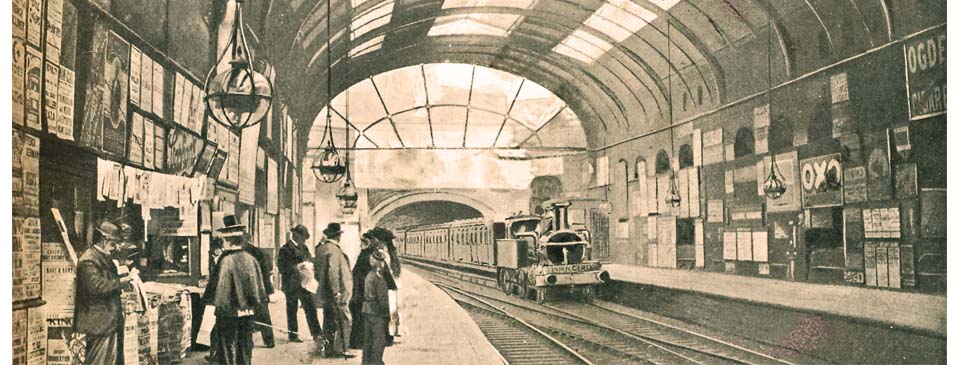The Metropolitan District railway – the creation of the Circle Line

Sloane Square station at the end of the 19th century. It was one of the original stations of the District Railway, opening on Christmas Eve 1868, and became a stop on the ‘inner circle’ upon its completion in 1884. Its construction was complicated by the underground River Westbourne crossing the line at that point. The river was carried over the station in a large pipe that can still be seen over the tracks today.
Traffic on the District line fell below expectations. There was stiff competition from omnibuses and steamboats that both offered lower fares and, unlike along the Metropolitan line, travellers could anyway move between rail termini due to the comprehensive network of overground railways south of the Thames.
Struggling with debt, the District was unable to complete the inner ring. Instead, in 1871 they changed their original plan and extended the line eastwards from Blackfriars to Mansion House, where it shared a station with the London & North Western Railway and the Great Western Railway. An opening banquet was attended by the Prime Minister, William Gladstone.
A branch of the District from Brompton to West Brompton opened in April 1869 and this would become the start of the District’s expansion to the south-west. The following year they secretly, and without parliamentary authority, opened a new line known as the Cromwell Curve in parallel with the Metropolitan, to avoid paying fees running over the Metropolitan tracks. It branched north to Kensington and east to Brompton and South Kensington. The parallel tracks continued in use until 1903.
Earls Court was then a sparsely populated district of market gardens so the line initially passed through without a station. Following petitions from local residents, a station was opened in October 1871, initially consisting of only a simple wooden booking office. That building burnt down in 1875, by which time the surrounding area had rapidly developed, stimulated by the accessibility of the station. A larger station opened in 1878.
Although initially successful, the Metropolitan railway, like the District, was by then struggling financially and in 1872 each of the companies appointed distinguished railway managers to guide them. James Staats Forbes, who had worked with Brunel on the construction of the Great West Railway and then saved the London, Chatham & Dover from bankruptcy, was appointed General Manager of the District, while Sir Edward Watkin became Chairman of the Metropolitan. The two had previously sparred when employed at the LC&DR and the South Eastern Railway respectively and animosity between the two men created many conflicts and delayed the eventual completion of the inner circle.
The Great Eastern Railway, which served the eastern part of England, moved its London terminus from Bishopsgate at Shoreditch into the City at Liverpool Street, opening in stages between 1874 and 1875. That prompted the Metropolitan Railway to extend their line the short distance from Moorgate to Liverpool Street, where their Bishopsgate Street station connected to the GER’s terminus. The Metropolitan and District railways were by then forming a horseshoe shape around London with their two eastern ends quite close to each other but as yet unconnected.
Instead, the District Railway continued to expand out of London in the west, over land that was cheaper to purchase. An extension to Hammersmith opened in September 1874, creating an alternative to the Metropolitan station. From there a branch reached Richmond via Kew in 1877. A branch from Turnham Green on that line to Ealing Broadway opened in 1879 and in 1880 the West Brompton branch was extended south to a new terminus at Putney Bridge. The line continued from there in 1889 with a railway bridge over the Thames, but this extension from Putney Bridge to Wimbledon was built and paid for by the London & South Western Railway.
The new forms of public transport available – omnibuses and railways – changed the daily lives and habits of Londoners, with increasing numbers of passengers on both. People no longer had to live within walking distance of their employment, as was the case as the beginning of the century and many were commuting quite long distances. By the 1870s more passengers were travelling by omnibus than before but taking shorter journeys, using them as a means to reach the nearest station instead of making their entire journey by road. The Metropolitan was carrying around 48 million passengers per year and the District about half that, of which about a third of passengers were using third class. The number of people using steamboats on the river, which had been popular in the earlier part of the century, was in decline as passengers switched to railways.
Over a decade after the parliamentary committee recommended the creation of an inner circle it had still not been completed. It took another step closer to fulfilment when in 1876 the Metropolitan line was extended further to Aldgate after pressure from the City of London Corporation. By then, financially ailing, the Metropolitan had also realised that tunnelling under expensive conurbation was not viable. Thereafter much of its expansion was to be overground through countryside to the north-west of London, branching out from Baker Street to Harrow and beyond.


